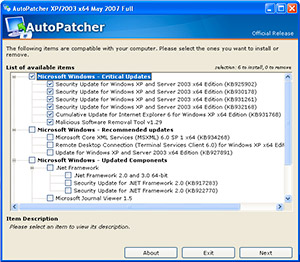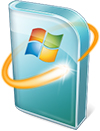 Microsoft Legal defies logic today by forcibly removing a free and trustworthy software package which makes updating Windows more convenient and accessible.
Microsoft Legal defies logic today by forcibly removing a free and trustworthy software package which makes updating Windows more convenient and accessible.
AutoPatcher, for those who don’t know, was an impressive Windows community project that combined publically available Windows hotfixes and security updates each month to form a single package that could either be installed in a batch or burned on to an CD. To those who regularly format their computers or fix other people’s computers (for which I share you pain), AutoPatcher not only saves bandwidth but precious time downloading each individual update from Windows Update.
 It is not hard to imagine AutoPatcher violated some clause in some terms of service somewhere, but why Microsoft would act on it, and act on it now is unbelievable. If AutoPatcher could be as “malicious” as Microsoft suggests, then why haven’t they acted on it sooner?
It is not hard to imagine AutoPatcher violated some clause in some terms of service somewhere, but why Microsoft would act on it, and act on it now is unbelievable. If AutoPatcher could be as “malicious” as Microsoft suggests, then why haven’t they acted on it sooner?
AutoPatcher has been an extremely active project since 2003, distributed somewhat 40,000 copies monthly over just the official download mirrors, not counting other popular sources such as Bittorent and even leading PC magazines worldwide. I might even go as far as to say some people depend on it.
The Microsoft official quoted on Neowin argues because Windows Update is more accessible now in other browsers like Firefox, AutoPatcher is more of a security concern. Did they forget AutoPatcher patches Windows? And what about those users who don’t have a fast-speed internet connection? Or maybe even no internet connection at all? Should those people visit the library each week to just keep their Windows up-to-date?
 Reasoning aside, AutoPatcher could well sidestep the legal roadblock by a simple but unproductive workaround. Microsoft argues updates should only be downloaded from the official Microsoft servers to prevent third-party modification, therefore AutoPatcher could instead of pre-bundling the updates, just fetch the updates from Microsoft’s own servers (HTTP downloads) to form a similar package on the user’s own computers at runtime. Might take a bit longer, but you can end up with the same package. As far as I know, you’re still allowed to archive Windows updates, thankfully.
Reasoning aside, AutoPatcher could well sidestep the legal roadblock by a simple but unproductive workaround. Microsoft argues updates should only be downloaded from the official Microsoft servers to prevent third-party modification, therefore AutoPatcher could instead of pre-bundling the updates, just fetch the updates from Microsoft’s own servers (HTTP downloads) to form a similar package on the user’s own computers at runtime. Might take a bit longer, but you can end up with the same package. As far as I know, you’re still allowed to archive Windows updates, thankfully.
As Microsoft continues to play down the importance of service packs in favor of Windows Update, the ability to collate and backup updates will be come more useful than ever. For that reason, I hope AutoPatcher, or a new project, will solve the problem without attracting the hounds.
This is a sad sad day.
I was an avid user of AP. It was always handy having a set of updates ready to roll from a CD/DVD for when you need to repair PCs/after a format (especially for users with dialup connections who need their computer to be up-to-date).
And yeah, it’s pretty hard to understand why Microsoft would suddenly react, even though the project has been operating for a number of years, without intervention by MS.
The German computer magazin c’t has a tool/script [1] that fetches the updates from Microsofts servers and creates CD/DVD images for offline patching.
[1] http://www.heise-security.co.uk/articles/80682
I’ve been using the “heise Offline Update” that Bjorn linked to above for quite a while.
It is a cool utility and works great on our support of WinXP/2000 machines. It also supports Win Server 2003 system patching.
Worth checking out for Autopatcher fans looking for a new solution. Downloads directly from the Microsoft servers via a wget process in DOS.
The first time it is run, it takes a while to bring down all the needed files. After that it checks the MS Updates catalog and only downloads new patches and/or patches that have been updated since download; so it is faster after each successive “update” run.
You can do individual ISO files for each system, or do a multi-system update download as well (though plan on putting that one on DVD!).
Multiple languages (for system localization) are supported.
Bjorn’s link is to the descriptive article.
The link below (page in German) is to the actual download page so you can monitor it for current version availability/updates.
http://www.heise.de/ct/projekte/offlineupdate/
Check out both.
Cheers.
theblazingangel has posted the takedown notice on Neowin, for those that want to read it.
http://www.neowin.net/forum/index.php?showtopic=584427&view=findpost&p=588813856
autopatcher should have been halted years ago. it was only left alive, for firefox users (who couldnt access windowsupdate back in the day).
Sucks.. but I rarely update anyway.
As usual Microsoft are freaking out that other people can do a better job than them, when it comes to updating MS are crap, thats why we needed Autopatcher.
crap how, daz? elaborate.
the biggest thing i liked about Autopatcher was not just the updates but all the settings and extras that you could specify. Like adding in WDS 3.01 and a few others as well as turning on ClearType and all the little bits and pieces we all like to configure post-installation.
@DAz: Windows Update is not crap for the majority of users, but it might be inefficient for some.
Then there is the fact that the Microsoft update process is entirely too complex, and not even Microsoft understands it. When my MS Update (which I always did in custom mode, and carefully) quit working, I thought it might be fun to see if Microsoft could solve the problem. First, though, I went to the MS IT tech site and found the files you need to build the CD for updates for a month for a specific OS. Of course, I did that.
Four months and some 200 emails (each way) later, MS tech support was up to the third iteration of the same lame diagnostics, suggested by the fifth tech support person, none of whom spoke English as a first language, which you can work around, but none of them knew anything much, either.
I finally fixed it myself.
I needed autopatcher for my Vista i cannot update it 🙁
One would think that MS would have cooperated with Autopatcher. Wannabe and experimental patchers will start popping up, resentful of MS with all the wrong sequences. It will end up reflecting on MS as Windows being the piece of Shiite that it really is.
bla bla..just dont use WINDOWS. its a piece of crappy shyt any way. switch to MAC or LINUX 😛
@blabla: This is a MICROSOFT blog. You’re just a troll.
Let him troll. He’s telling the truth. Windows IS crap. And this is coming from almost 20 years of using it.
As for Autopatcher…
Microsoft probably did it because they realized a few things:
1. That Windows really is shitty and if they had to keep making patches for every flaw they carelessly baked into Windows they would not have enough time to rip off features and software from Mac OS and Linux for the next version of Windows.
2. The product offered nothing in the way of actually making users and vendors hopelessly dependent on them. If they’re not going to make money off it, they must have some value in it illegally beating a market into submission.
3. It wasn’t shitty enough to fit in with Windows.
You must pick two of these three. However, all three are extremely likely.